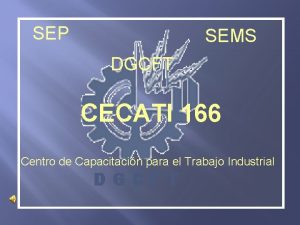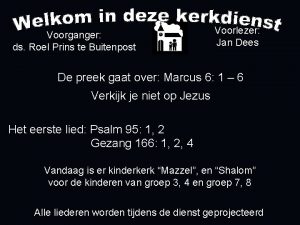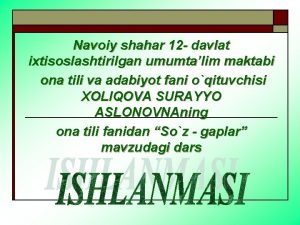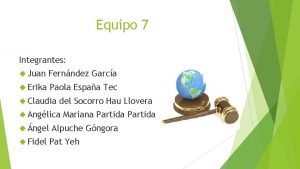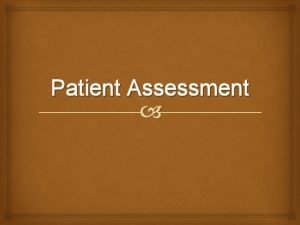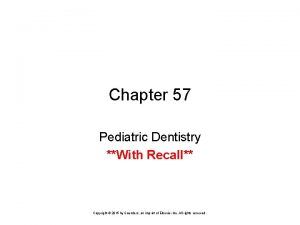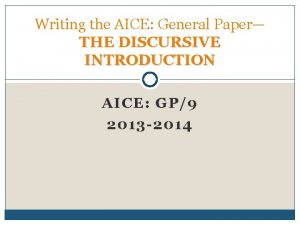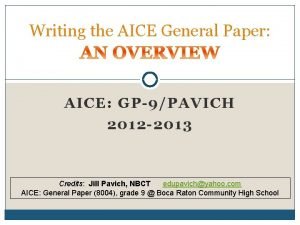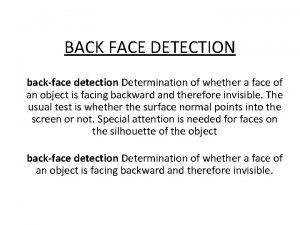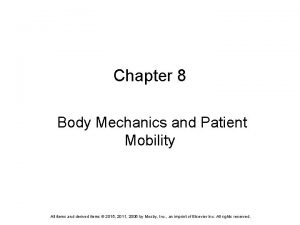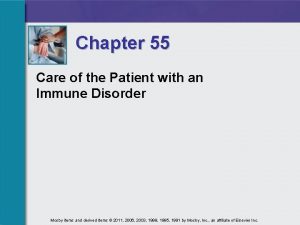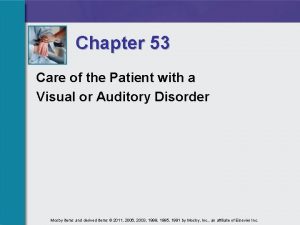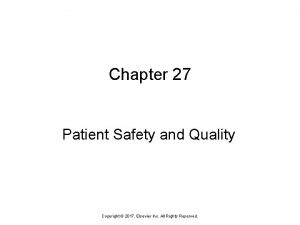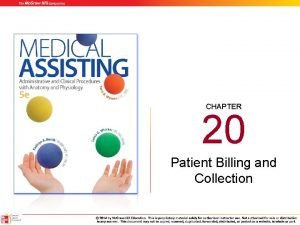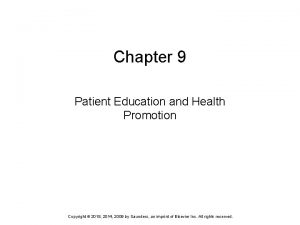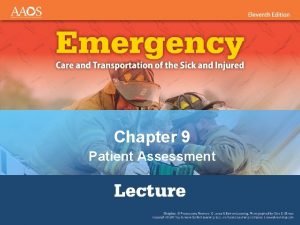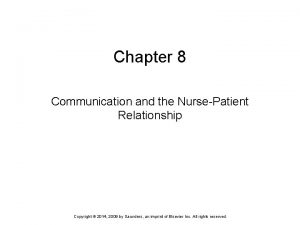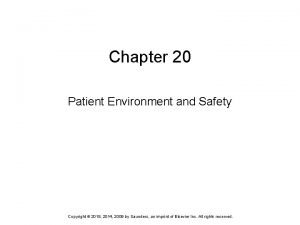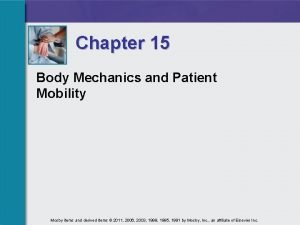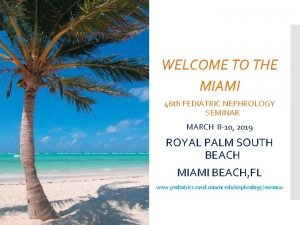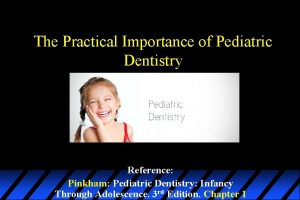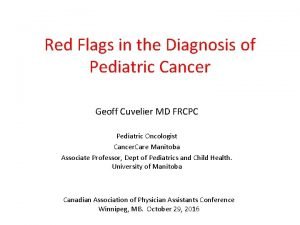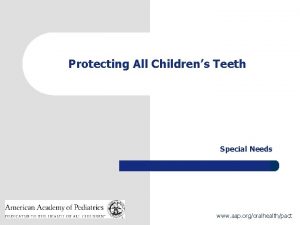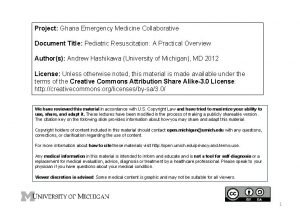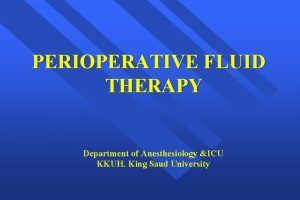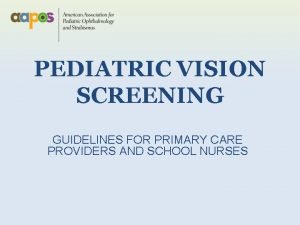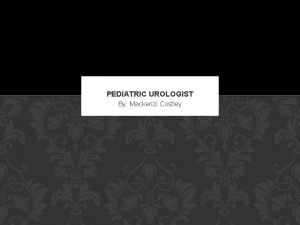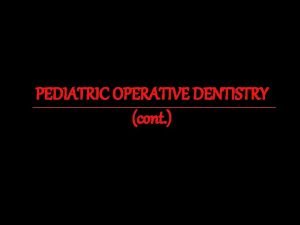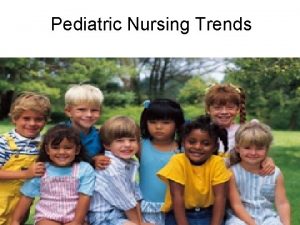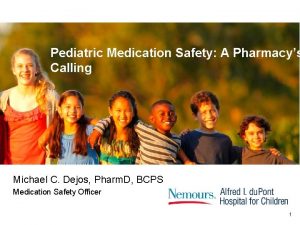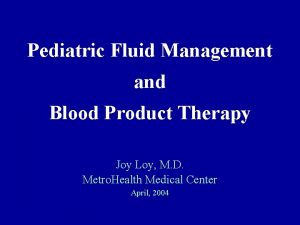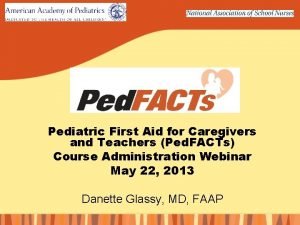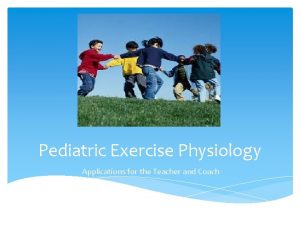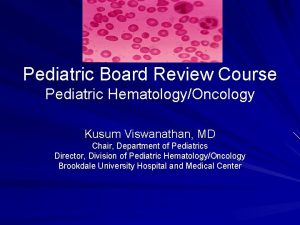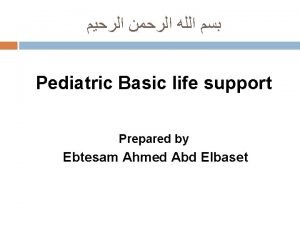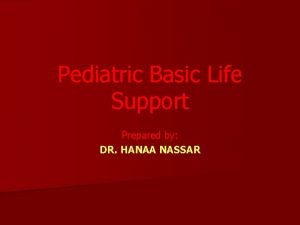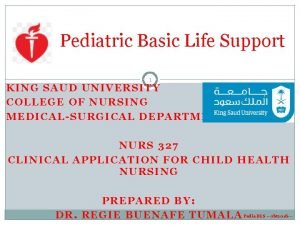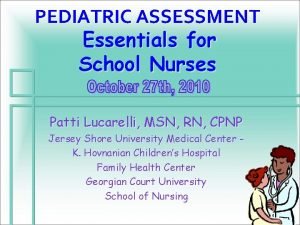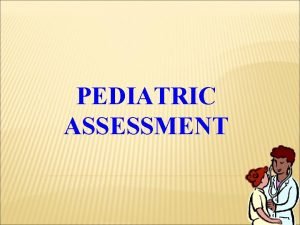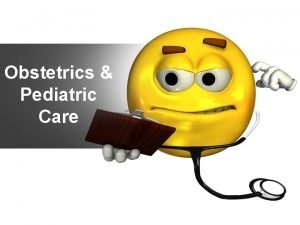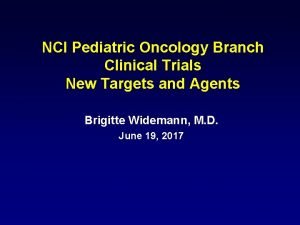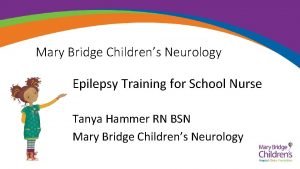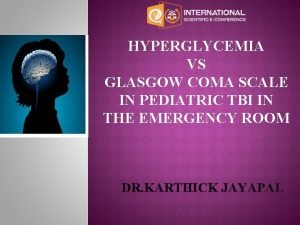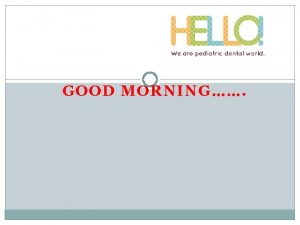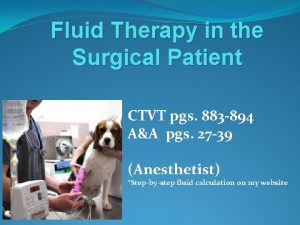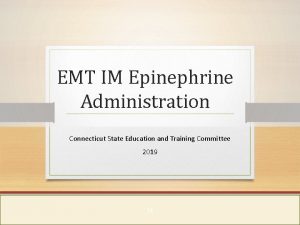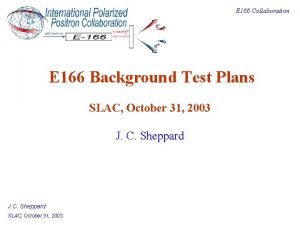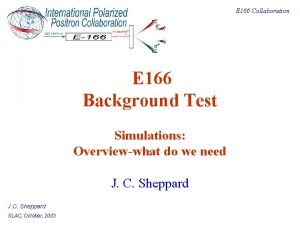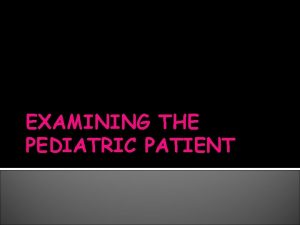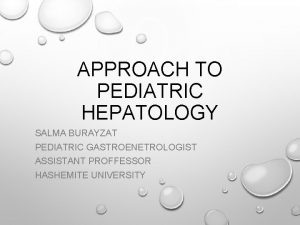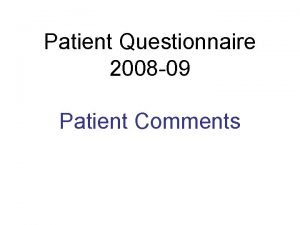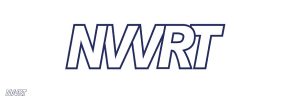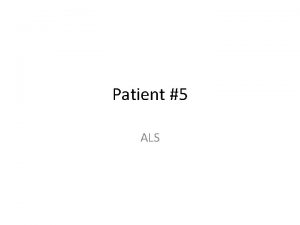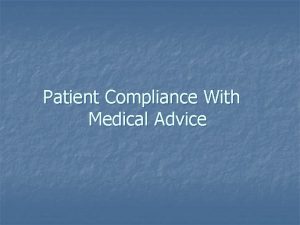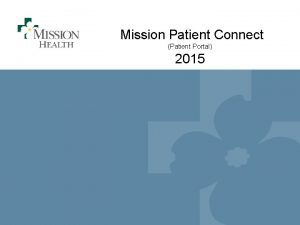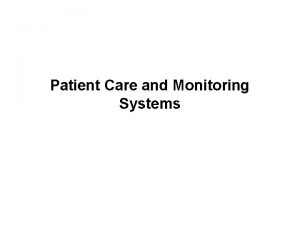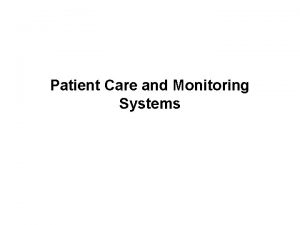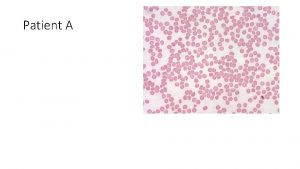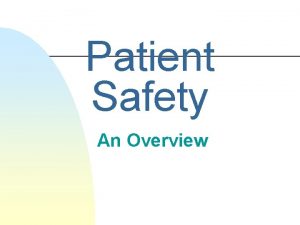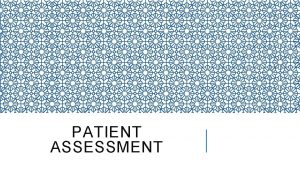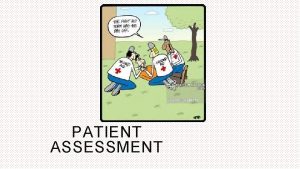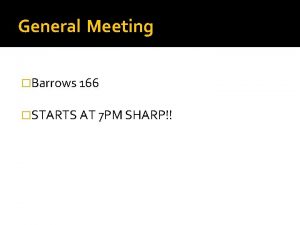Chapter 166 General Approach to the Pediatric Patient











































































































- Slides: 107

Chapter 166. General Approach to the Pediatric Patient 2018. 3. 29 정재윤

DISTINGUISHING PRINCIPLES OF DISEASE TEMPERATURE REGULATION AIRWAY CARDIOVASCULAR MUSCULOSKELETAL IMMUNOLOGIC PHARMACOLOGIC



Airway • Large tongues: NP airway • Small airways: obstruction by secretion Airway suctioning • Breathe through their noses: obstruction by secretion • Large occiputs: obstruction at supine position A shoulder roll

Cardiovascular • Heart rate – Tachycardia: fever, anxiety, pain, or fear, cardiovascular compromise의 early sign – Bradycardia: cardiopulmonary failure and impending cardiac arrest. – 반복측정이 중요하다 – Pulse는 약한데 tachycardia가 있으면 shock state라고 고려해야 한다 • Blood pressure – Compensatory mechanism: increased HR, systemic vascular resistance – Hypotension은 shock의 late finding


Immunologic and pharmacologic • Immunologic – Immature immune system – Prone to infection – < 1 moth with fever: SBI risk up to 10% full sepsis w/u • Pharmacologic – Weight based dosing – Medication errors: frequent • Simple calculation mistakes • Scale mistakes: pounds vs kilograms • Medication should not young infants but frequently prescribed to adults: ceftriaxone causing bilirubin encephalopathy

DEVELOPMENTAL YOUNG INFANTS (<12 MONTHS OF AGE) TODDLERS (1 - TO 2 -YEAR-OLDS) PRESCHOOLERS (3 - TO 5 -YEAR-OLDS) SCHOOL-AGE CHILDREN ADOLESCENTS


EVALUATION HISTORY PEDIATRIC ASSESSMENT TRIANGLE APPEARANCE WORK OF BREATHING CIRCULATION LENGTH-BASED RESUSCITATION TAPE PHYSICAL EXAMINATION


Pediatric Assessment triangle (PAT) • Critically ill patients는 빨리 찾아내는 방법

Pediatric Assessment triangle (PAT)

Pediatric Assessment triangle (PAT)

PAT: Appearance, 때깔 • General appearance observation (멀리서) • TICLS check (Tone, Interactiveness, Consolability, Look/Gaze, Speech/Cry) • Mental status, irritability, lethargy, response check • Irritability: early sign of inadequate brain perfusion • 멍한 눈으로 꼭 주변에 아무도 없는 것처럼 반응 없음 ü septic 하다거나 아니면 brain에 문제가 있음을 고려 • Cephalic cry ü shrill or high-pitched penetrating cry ü suggests intracranial damage, meningitis • Good appearance ü ventilation, oxygenation, brain perfusion 이 좋다고 가정해 볼 수 있다.

PAT: Work of Breathing • 숨쉬는 것도 조금 멀리 떨어져서 보자 • 일단 아이가 울기 시작하면 모든 게 끝장임 • 청진 시 주의 깊게 grunting, wheezing, stridor, snoring이 있는지 듣자 • Increased work of breathing 시에 나타나는 현상 ü sniffing position: obstruction을 극복하기 위한 자세 ü Tripoding: accessory m. 을 최대한 사용하기 위한 자세 ü Retractions (intercostal, supraclavicular, substernal) ü Seesaw movements of the chest and abdomen ü Nasal flaring ü Head bobbing • Effortless tachypnea, or rapid respirations without increased work of breathing ü 대부분 여러 원인의 metabolic acidosis시에 호흡으로 보상하는 경우 나타남 ü Shock의 sign

PAT: Work of Breathing


Length-Based Resuscitation Tape and physical exam • Length-Based Resuscitation Tape (Broselow tape) • Physical examination – Mental status 평가: GCS, AVPU – Order of examination (자극적이지 않은 것 부터) • 청진 귀, 입안 검사 – Tympanic membrane 검사 – Vaginal examination • 엄마 무릎 위, frog leg

Glasgow coma scale for children

SPECIFIC DISORDERS CHILDREN WITH SPECIAL HEALTH CARE NEEDS NEONATAL INTENSIVE CARE UNIT GRADUATE ALTERED MENTAL STATUS SEIZURES TRAUMA CHILD ABUSE

NICU graduate • Premature baby: gestational age를 기준으로 발달력을 확인 • Increased respiratory infection compared with term infants • Chronic lung disease due to severe prematurity • History시 반드시 check 해야 함

Altered mental status • AEIOUTIPS


Child abuse • 영아 진료 시 반드시 한번은 생각해야 보아야 할 문제 – Mechanism inconsistent with the injury – History inconsistent with the developmental level of the child (Box 166 -3). – Physical examination clues • Bruises in young infants • Bruises on certain areas of the body, such as the ear and trunk 24 (Box 166 -4). – Fractures in children younger than 18 months without a significant witnessed trauma mechanism

Chapter 106. Emergency Care of Children


Clinical features – History

Clinical feature – physical examination • 고려사항 – V/S (including temperature) – 나이, 측정 장소, 질환에 따라 – P/E 방법 ü나이(infant, 1 -3세 소아), 검진 순서(not invasive first) § Tone and mental status(때깔) – most important, 자극에 대한 반응 üNot reliable PE findings § Meningismus(15% in bacterial meningitis), Focal RLQ tenderness (ambiguous) üCautious PE findings § Skin temperature, skin color, capillary refill time, ausculation – High suspicion이 가장 중요


Diagnosis - Imaging • 영상의학적 검사를 시행할 때 고려해야 할 사항 – Radiation exposure üCancer risk (single CT 2, 000 infants중에 1명, 5, 000 children 1명) üLong term neurologic outcomes – Risks for sedation – Prefer Ultrasonography

Treatment • Special considerations – 나이 (신생아, 영아, 소아) – Hypotension (late phase에 나타남) – Respiratory arrest가 많다 – 약물 투여 (dosae for kilogram)


CHAPTER 112. INTRAVENOUS AND INTRAOSSEOUS ACCESS IN INFANTS AND CHILDREN



Intraosseous access

Manual needles Disposable Jamshidi intraosseous needle Cook-type IO needle Rosenthal aspiration needle 16 -18 gauge spinal needle Butterfly needle

Mechanical devices BIG (Bone Injection Gun) EZ-IO by Vidacare Pyng Medical's F. A. S. T. 1

Mechanical devices

Principle

Location

Location

Other Location

New IO devices – BIG

New IO devices – EZ-IO

New IO devices – FAST 1

Central venous access in infants • Central cath type – 5 Fr : infants and neonates – 6 Fr: > older – 3 Fr: preterm • Methods (=like adults) – Subclavian • Pneumothorax가능성 높다 • Shoulder roll을 받치지 말자 – Internal jugular • Valsalva, liver compression, Trendelenburg – helpful to young children not infants – Femoral • Relatively easy and safe. • not related higher infection in children • Favorable at 30 -60도 abduction d/t femoral a/v overlap

Chapter 115. Sudden Infant Death Syndrome and Apparent Life-Threatening Event

SUDDEN INFANT DEATH SYNDROME



Pathophysiology • 아직 잘 모름 (현재까지 70개 이상의 이론이 있음) • 여러 가지 theories (mechanism에 대한 다양한 연구가 이루어지고 있다) ü 보호자에게 눌려 질식 ü Milk allergy ü Thymic enlargement ü Cardiac dysfunction including dysarrythmia ü medullary serotonergic pathology ü environmental stressors ü poverty, or prenatal exposure to cigarettes, alcohol, and illicit drugs ü genetic factors, male gender ü Sleep habit (supine prone)



APPARENT LIFE-THREATENING EVENT

Apparent Life-Threatening Event (ALTE) • 정의 – 보호자를 놀라게 하는 다음과 같은 event üApnea üColor change(cyanosis, pallor, or plethora) üChange in muscle tone (limp or stiff) üChoking or gagging • Incidence – Peak: 1주에서 2개월 사이 – 대부분 10주 이내에 발생 • Risk factors – RSV infection, prematurity, recent anesthesia – known gastroesophageal reflux or airway/maxillofacial anomalies


ALTE 증상의 예) 정상으로 볼 수 있는 모든 신생아의 physiologic event가 포함된다 – – Apnea Periodic breathing Prematurity의 apnea Changes in skin color üCyanosis (perioral cyanosis, acrocyanosis) d/t polycythemia üPlethora üPallor d/t increased vagal tone such as GERD – Changes in muscle tone üSeizure üPostictal status üHypoxia에 의해 2차적으로 발생 üStiffening and arching behavior – Chocking, gagging and coughing – Incoordination of the normal suck-swallow-breath sequence

Epidemiology – 정확하진 않지만 대략 0. 05% to 6. 0% – 전체 영아의 0. 05% to 6. 0%가 ALTE로 인한 입원 – Peak incidence: 1주에서 2개월 사이 – 10주 이내에 발생 – 남: 녀 = 2: 1 – Known risk factors • RSV infection, prematurity, recent anesthesia • known gastroesophageal reflux or airway/maxillofacial anomalies.

Differential diagnosis • 25 -50% 이상은 원인을 알지 못함 = idiopathic ALTE

Differential diagnosis – Gastroesophageal Reflux Disease (특히 pathologic GERD) – Bronchiolitis (RSV인경우 apnea와 연관이 있다고 알려짐) – Seizures (4 -7% 차지, apnea가 유일한 증상일 수도) – Nonaccidental Trauma/Poisoning (질식, 두부외상, 중독, abuse) – Pertussis (apnea가 pertussis의 sole Sx일 수도) – Serious Bacterial Infections – Breath-Holding Spells (1분 미만, cyanosis, pallor, syncope, seizures 모두 동반될 수 있다. )


CHAPTER 111. NEONATAL EMERGENCIES AND COMMON NEONATAL PROBLEMS


NORMAL VEGETATIVE FUNCTIONS AND COMMON CONCERNS OF CAREGIVERS OF NORMAL INFANTS

Normal Vegetative Functions and Common Concerns of Caregivers of Normal Infants • 모든 신생아가 똑같을 순 없다. • Normal variants로 인해 부모들이 ER 방문이 많다 • 먹는 pattern, 체중 증가, 변, 피부, 호흡 등등









CONSIDERATIONS IN THE CRITICALLY ILL NEONATE

Critically ill 신생아게 고려해야 할 사항 • Respiratory system Ø Compliant chest wall increase inspiratory force Ø Small neonatal airway, obligate nose breathing obstruction Ø High metabolic rate increased oxygen consumption Ø limited functional residual capacity Ø Abdominal distention. Ø Positive pressure ventilation, endotracheal intubation and nasogastric decompression • Cardiovascular system Ø Bradycardia 거의 대부분 hypoxia에 의한 2차적 현상 Ø Congenital heart ds (two types) ØFirst week of life (ductus arteriosus가 닫히면서 증상) hypoplastic left heart syndrome, coarctation of the aorta ØSecond week of life (pul. Resistance가 떨어지면서 증상) left-to-right shunting of blood (ventricular and atrial septal defects)

Critically ill 신생아게 고려해야 할 사항 • In born errors of metabolism Ø 대부분 쳐지고 심폐 collapse로 내원 Ø 의심 시 glucose, VBGA, ammonia, urine ketone 검사는 시행해야 Ø 다른 검사는 일단 resuscitation 부터 하고 나서 하자 Ø 응급 처치는 dextrose가 포함된 수액으로 충분한 경우가 많다 • • Congenital adrenal hyperplasia Sepsis Intracranial hemorrhage Abdominal catastrophe Ø Malrotation midgut volvulus

SYMPTOM-BASED NEONATAL PROBLEMS AND EMERGENCIES

Diaper Rash and oral thrush • 기저귀 발진의 두 가지 type ØContact dermatitis • Stool과 접촉하여 발생 • 잘 말려주고 zinc oxide(barrier 역할)등을 발라준다 ØCandidal diaper dermatitis • 기저귀 하는 애들에서 습하고 피부가 접혀진 곳에 잘생김 • Nystatin cream을 기저귀 갈 때 마다 도포 혹은 하루에 4번 도포 • 마찰 방지 위해 zinc oxide 도포 • Oral thrush (candidal lesion) Ø 우유찌꺼기와 구분하는 방법은 설압자로 긁어서 안 긁히면 oral thrush Ø 통증 유발, poor oral intake유발 Ø Topical nystatin, gentian violet Ø 필요 시 Anesthetic gel for feeding

CARDIORESPIRATORY SYMPTOMS


Noisy Breathing and Stridor • Stertor Ø 흡기시 코고는 소리 양상 Ø 일반적으로 benign Ø choanal stenosis도 고려해 봐야 (NG tube 넣어서 통과 안되면. . ) • Stridor Ø Laryngomalacia Ø Congenital anomaly of trachea, bronchus Ø Worsening with cry or increased activity: laryngomalacia, tracheomalacia, or subglottic hemangioma Ø Worsening by feeding: vascular ring, laryngeal cleft, or TEF Ø Tracheal stenosis Ø With hoarseness or weak cry: vocal cord paralysis Ø Subglottic stenosis: post intubated neonate Ø Infection(croup, epiglottitis, and abscess): rare




Vomiting • Metabolic and Endocrinologic Disorders – 응급실에 내원한 신생아가 의식의 변화가 있고 혈당이 낮으면 바로 의심해야 함 – Inborn errors of metabolism – Congenital adrenal hyperplasia – Lab results ü hypoglycemia, metabolic acidosis ü hyperammonemia, or electrolyte disturbances – Emergency treatment ü 즉각적인 수액 공급, Dextrose가 포함된 수액(일단 시간을 벌자) ü 저혈당, 전해질 이상 교정 ü Steroids 투여 고려 (hydrocortisone, 12. 5 to 25. 0 milligrams IM, IV, or IO)

Necrotizing Enterocolitis • 글쎄 원인 아직 잘 모름 (다양한 원인이 섞여 있지 않을까…) • 미숙아에게 많다 하지만 정상 신생아에서도 있을 수 있다. • Symptoms ü 잘 안 먹으려하고 복부팽만, 복벽에 color change, 무호흡, shock ü 다양한 presentation을 할 수 있다. • X-ray finding ü pneumatosis intestinalis (intramural air) 과 hepatic portal air ü X-ray는 Lt lateral decubitus로 찍어야 free air가 잘 보임 • Management ü Bowel rest + broad spectrum antibiotics(ampicillin, cefotaxime, and clindamycin)

Blood in the Diaper • 진짜 blood인지 확인하자 ü Urinary crystals: 오렌지색 혹은 빨간색 ü Stool guaiac test가 도움이 될 수 있음(occult blood를 확인하는 방법) • Blood가 맞다 면 어디서 나온 건지 확인하자 ü GI tract? , vagina? , especially girls ü Bloody or mucus discharge in girl neonates: placenta estrogen withdrawal 때문에 있을 수 • Anal fissure가 있는지 잘 살펴보자 • 시간에 따른 bloody stool ü첫 2 -3일의 blood in diaper ü swallowed maternal blood, Kleihauer-Betke or Apt-Downey test (감별을 위해서는) ü수일이 지난 후의 bloody stool ü idiopathic, but coagulopathies, necrotizing enterocolitis, allergic or infectious colitis, and congenital defect등 고려



Diarrhea and Dehydration • 필요한 신체 검진 및 검사 ü 점막 검사: 축축한지 아닌지 ü Anterior fontanel, eyes: 쏙 들어가있는지 여부 ü Skin: turgor 검사 ü Mental status : 보호자와의 유대 반응 ü Temperature, pulse, blood pressure ü Rectal exam ü Stool exam ü p. H ü electrolytes (Na), glucose: 반드시 check ü Serum creatinine (Cr): 1. 0 mg/d. L도 정상보다 2배 이상이라는 것을 명심하자 • Management ü < 5%: ORS 먹이자 ü 혹시 수유 중이라면 수유는 지속하고 전해질과 당만 공급해 주자 ü > 5%: iv hydration



Jaundice • Physiologic jaundice ü <5 mg/d. L, 첫 1일 ü 5~6 mg/d. L, 2 -4일 ü <2 milligrams/d. L, 5 -7일 • 대게 6 mg/d. L 이상이면 abnormal하다고 판단 • 응급실에서 겪는 jaundice의 원인 ü physiologic jaundice, breastfeeding jaundice ü breast milk jaundice, or jaundice due to infection.

Jaundice

EYE COMPLAINTS

• Watery Eyes ü 정상적으로 눈곱이 끼고 discharge가 있을 수 있다. ü 실제 아이의 눈물샘관은 좁아져 있어서 이런 현상이 나타남 ü 12개월 넘어서까지 증상이 지속되면 안과 consult필요 • Red Eye and Irritation ü 주로 corneal abrasion d/t 본인의 손 안과 검진 ü Acute glaucoma 드물다, 바로 안과 치료 필요 ü Eye Discharge and Redness • Eye Discharge and Redness – Conjunctivitis üChlamydia trachomatis, Neisseria gonorrhoeae 항생제 üViral cause conservative üHerpes simplex conjunctivitis + vesicle full sepsis w/u , acyclovir – Gonococcal infection cefotaxime – Chlamydia conjunctivitis macrolide

NEONATAL SEPSIS


• 주 원인 균 üβ-hemolytic streptococci : ampicillin üenteric organisms (E. coli, Klebsiella species, H. influenza) : aminoglycoside (gentamicin, if meningitis, cefotaxime, ceftazidime) üListeria monocytogenes: ampicillin üEnteroviruses (coxsackievirus and echovirus) üHerpes: acyclovir • Full sepsis w/u including spinal tapping

NEUROLOGIC COMPLAINTS

Abnormal Movements and Seizures • Seizure movement와 감별해야 할 movement ü benign sleep myoclonus ü rhythmic myoclonic jerks, 잠잘 때 정상적으로 나타나는 ü 건드리거나 깨우면 없어짐 • Tetany ü Associated hypocalcemia ü Di. George syndrome • Sz인지 아닌지 감별하는 게 중요함 • 아주 미묘한 움직임도 Sz일 수 있음 ü eye deviation, tongue thrusting, eyelid fluttering, apnea, pedaling movements, or arching

CHAPTER 145. DIABETES IN CHILDREN

Pediatric DKA • Definition – p. H<7. 30 – HCO 3 < 15 m. Eg/L – Hyperglycemia > 200 mg/d. L – Ketonemia or ketouria • Sx – Due to dehydration and metabolic acidosis – Depressed consciousness (cerebral edema? ) – Abdominal pain and vomiting • DDX – Vomiting + Ketoacidosis + normal glucose toxic 감별 (ethylene glycol, alcohol, salicylates)

Management
 Cecati 166
Cecati 166 Gezang 166
Gezang 166 Fas 166
Fas 166 Soneto 166
Soneto 166 165 mashq
165 mashq Ley general del ambiente
Ley general del ambiente Patient 2 patient
Patient 2 patient General history taking of patient
General history taking of patient Chapter 57 pediatric dentistry recall
Chapter 57 pediatric dentistry recall Datagram switching vs virtual circuit switching
Datagram switching vs virtual circuit switching Theoretical models of counseling
Theoretical models of counseling Waterfall approach vs shower approach
Waterfall approach vs shower approach Multiple approach-avoidance conflict
Multiple approach-avoidance conflict Cognitive approach vs behavioral approach
Cognitive approach vs behavioral approach Research approach means
Research approach means Diagram for traditional approach
Diagram for traditional approach Deep learning approach and surface learning approach
Deep learning approach and surface learning approach Aice general paper discursive essay
Aice general paper discursive essay Aice general paper rubric
Aice general paper rubric Back detection
Back detection Aice writing
Aice writing The hand approach general paper
The hand approach general paper Hình ảnh bộ gõ cơ thể búng tay
Hình ảnh bộ gõ cơ thể búng tay Lp html
Lp html Bổ thể
Bổ thể Tỉ lệ cơ thể trẻ em
Tỉ lệ cơ thể trẻ em Gấu đi như thế nào
Gấu đi như thế nào Glasgow thang điểm
Glasgow thang điểm Hát lên người ơi
Hát lên người ơi Môn thể thao bắt đầu bằng chữ đua
Môn thể thao bắt đầu bằng chữ đua Thế nào là hệ số cao nhất
Thế nào là hệ số cao nhất Các châu lục và đại dương trên thế giới
Các châu lục và đại dương trên thế giới Công thức tiính động năng
Công thức tiính động năng Trời xanh đây là của chúng ta thể thơ
Trời xanh đây là của chúng ta thể thơ Mật thư anh em như thể tay chân
Mật thư anh em như thể tay chân Làm thế nào để 102-1=99
Làm thế nào để 102-1=99 độ dài liên kết
độ dài liên kết Các châu lục và đại dương trên thế giới
Các châu lục và đại dương trên thế giới Thơ thất ngôn tứ tuyệt đường luật
Thơ thất ngôn tứ tuyệt đường luật Quá trình desamine hóa có thể tạo ra
Quá trình desamine hóa có thể tạo ra Một số thể thơ truyền thống
Một số thể thơ truyền thống Cái miệng xinh xinh thế chỉ nói điều hay thôi
Cái miệng xinh xinh thế chỉ nói điều hay thôi Vẽ hình chiếu vuông góc của vật thể sau
Vẽ hình chiếu vuông góc của vật thể sau Thế nào là sự mỏi cơ
Thế nào là sự mỏi cơ đặc điểm cơ thể của người tối cổ
đặc điểm cơ thể của người tối cổ V. c c
V. c c Vẽ hình chiếu đứng bằng cạnh của vật thể
Vẽ hình chiếu đứng bằng cạnh của vật thể Tia chieu sa te
Tia chieu sa te Thẻ vin
Thẻ vin đại từ thay thế
đại từ thay thế điện thế nghỉ
điện thế nghỉ Tư thế ngồi viết
Tư thế ngồi viết Diễn thế sinh thái là
Diễn thế sinh thái là Dạng đột biến một nhiễm là
Dạng đột biến một nhiễm là Số nguyên tố là số gì
Số nguyên tố là số gì Tư thế ngồi viết
Tư thế ngồi viết Lời thề hippocrates
Lời thề hippocrates Thiếu nhi thế giới liên hoan
Thiếu nhi thế giới liên hoan ưu thế lai là gì
ưu thế lai là gì Sự nuôi và dạy con của hổ
Sự nuôi và dạy con của hổ Khi nào hổ mẹ dạy hổ con săn mồi
Khi nào hổ mẹ dạy hổ con săn mồi Sơ đồ cơ thể người
Sơ đồ cơ thể người Từ ngữ thể hiện lòng nhân hậu
Từ ngữ thể hiện lòng nhân hậu Thế nào là mạng điện lắp đặt kiểu nổi
Thế nào là mạng điện lắp đặt kiểu nổi Diferencia entre gran plano general y plano general
Diferencia entre gran plano general y plano general Where did general lee surrender to general grant?
Where did general lee surrender to general grant? Purpose of neurovascular assessment
Purpose of neurovascular assessment Chapter 55 care of the patient with an immune disorder
Chapter 55 care of the patient with an immune disorder Chapter 53 care of the patient with a sensory disorder
Chapter 53 care of the patient with a sensory disorder A nurse floats to a busy surgical unit
A nurse floats to a busy surgical unit The process of classifying and reviewing past due accounts
The process of classifying and reviewing past due accounts Patient readiness to learn
Patient readiness to learn Chapter 9: patient assessment worksheet answers
Chapter 9: patient assessment worksheet answers Chapter 8 communication and the nurse patient relationship
Chapter 8 communication and the nurse patient relationship Chapter 20 patient environment and safety
Chapter 20 patient environment and safety Body mechanics and mobility
Body mechanics and mobility Unc hematology oncology current fellows
Unc hematology oncology current fellows Miami pediatric nephrology seminar
Miami pediatric nephrology seminar Pinkham pediatric dentistry
Pinkham pediatric dentistry Pediatric headache red flags
Pediatric headache red flags Pediatric seizures
Pediatric seizures Pediatric normal vital signs
Pediatric normal vital signs Pediatric maintenance fluids 4-2-1 rule
Pediatric maintenance fluids 4-2-1 rule Pediatric vision screening guidelines
Pediatric vision screening guidelines Pediatric urology salary
Pediatric urology salary Pediatric heart rate chart
Pediatric heart rate chart Pediatric class 2 prep
Pediatric class 2 prep Trends of pediatric nursing
Trends of pediatric nursing Common pediatric medications
Common pediatric medications Pediatric iv medication administration guidelines
Pediatric iv medication administration guidelines Pediatric fluids 4 2 1
Pediatric fluids 4 2 1 Pediatric first aid for caregivers and teachers
Pediatric first aid for caregivers and teachers Pediatric exercise physiology
Pediatric exercise physiology Kusum viswanathan
Kusum viswanathan Pat pediatric assessment
Pat pediatric assessment Basic life support
Basic life support Pediatric life support algorithm
Pediatric life support algorithm Normal vital signs for adults
Normal vital signs for adults Pediatric vital signs
Pediatric vital signs Pediatric assessment triangle ticls
Pediatric assessment triangle ticls Nci pediatric oncology branch
Nci pediatric oncology branch Modern concept of child health nursing
Modern concept of child health nursing Modern concept in child health care pdf
Modern concept in child health care pdf Mary bridge pediatric neurology
Mary bridge pediatric neurology Pediatric coma scale
Pediatric coma scale Father of indian pediatric dentistry
Father of indian pediatric dentistry Crystalloids and colloids examples
Crystalloids and colloids examples Emt 6 rights
Emt 6 rights
